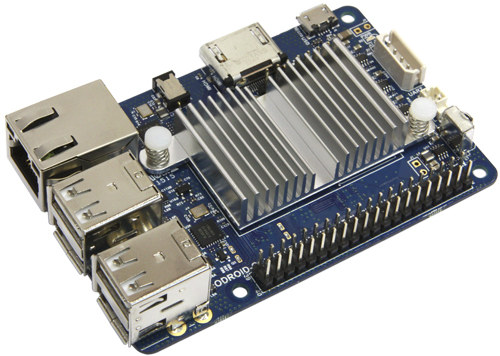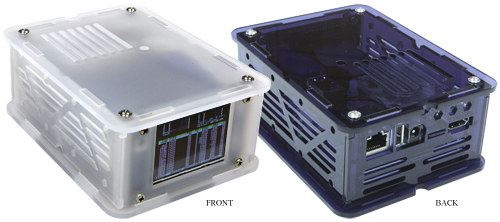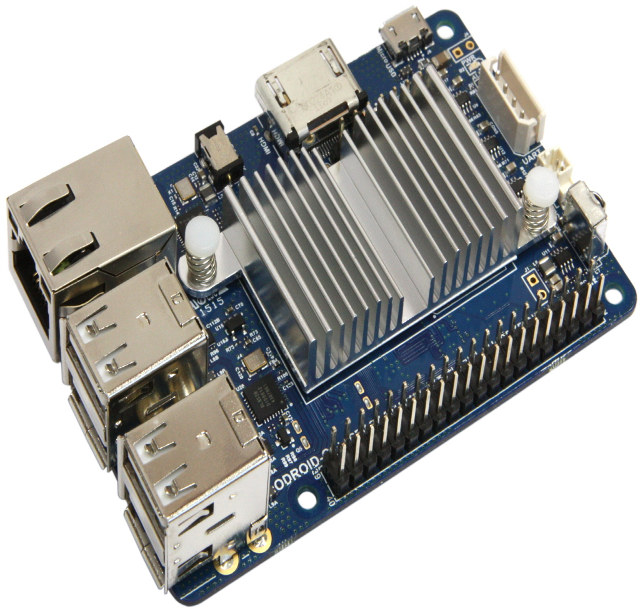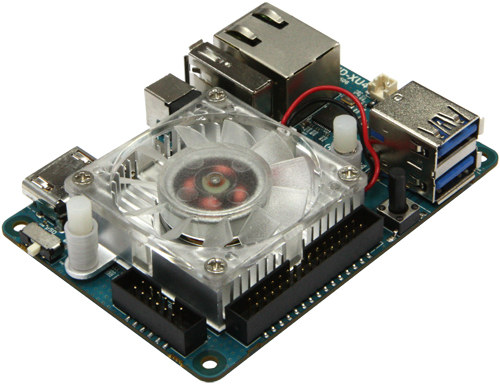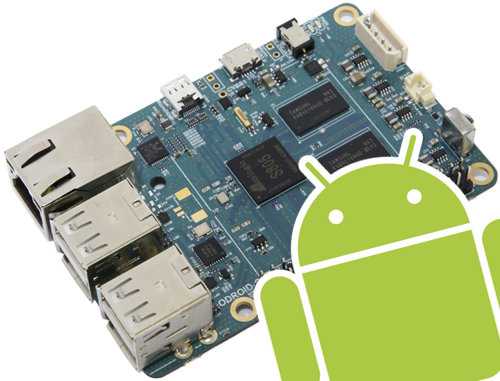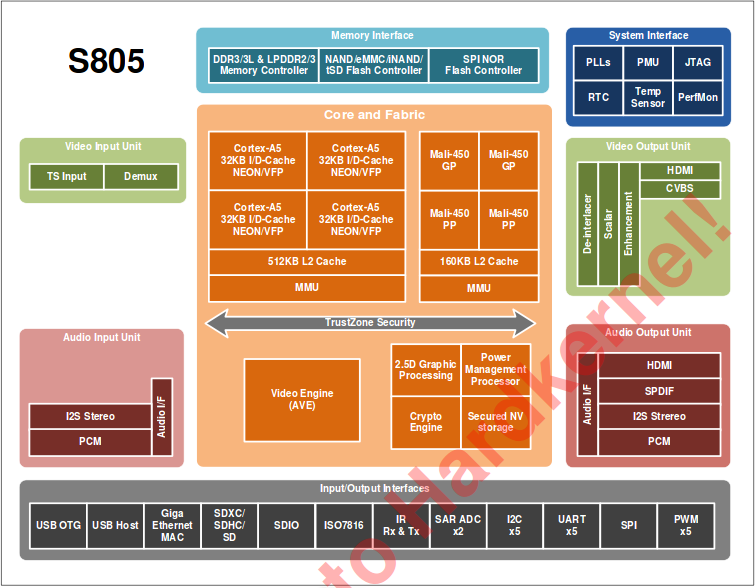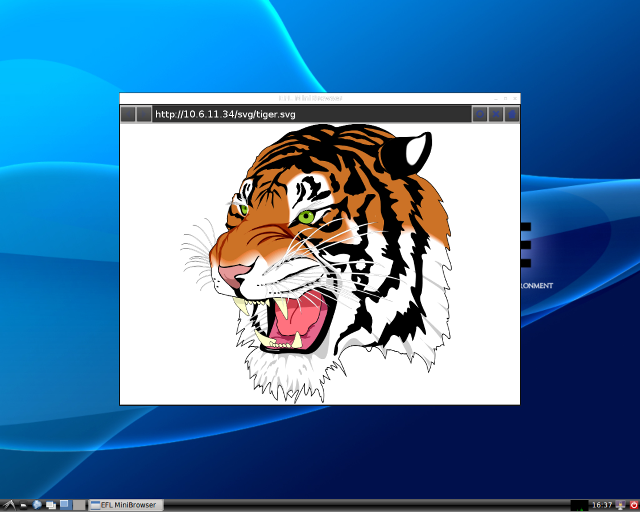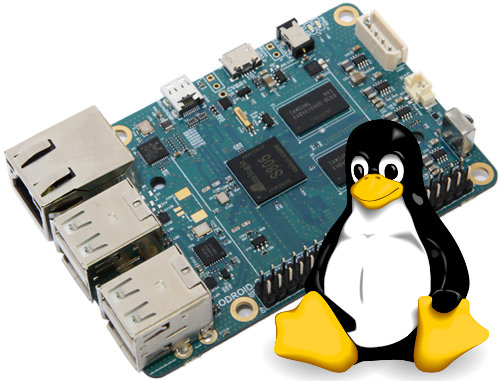We already knew Hardkernel was working on ODROID-C1+ development board, an update the popular ODROID-C1 board with the same Amlogic S805 processor, storage and memory, but with a standard HDMI port replacing the micro HDMI port, I2S support, better micro SD card and HDMI-CEC support, an micro USB OTG port that can be used to power the board, and an included heatsink. The board is now up for sale for $37, or just $2 more than the original ODROID-C1 board. ODROID-C1+ specifications: SoC- Amlogic S805 quad core Cortex-A5 processor with a quad core Mali-450MP2 GPU System Memory – 1GB DDR3 Storage – eMMC 4.5 HS200 module socket for up to 64GB storage, and UHS-1 SDR50 micro SD slot Video & Audio Output – Type A HDMI port with CEC support Connectivity – Gigabit Ethernet USB – 4x USB 2.0 host ports, 1x micro USB OTG port Expansion Headers 40-pin Raspberry […]
Cloudshell for XU4 is a $39 NAS Kit for ODROID-XU4 Board
Hardkernel launched ODROID-XU4 development board a couple of weeks ago. The board is a low cost ($74) update to ODROID-XU3 development board, with an Exynos 5422 octa core processor (4x A15, 4x A7), 2GB RAM, Gigabit Ethernet and USB 3.0, making it a pretty good target for a NAS. It’s easy to connect all requires parts such as hard drive and power supply together, but it would normally be a mess on your desk. So the company create a NAS kit for the board with an enclosure, cables, fans, and even an LCD display with they call Cloudshell for XU4 for sell for $39, so you can get a high relatively high performance NAS for around $113 + shipping, which will vary depending on your distributor, as well as an HDD or SSD drive. Cloudshell kit content: Enclosure with top and bottom covers, rear, front and side panels. Available in […]
ODROID-C1+ Board is an Upcoming Upgrade to ODROID-C1 Board
ODROID-C1 board has been relatively popular thanks to its great hardware features and good software support for its $35 price tag. In mid-June however, ODROID-C1 got out of stock due to sudden large orders, and it was only scheduled to sale again in early August because of long leadtime for some components. It turns out ODROID-C1 may never sell again, simply because it will be replaced by ODROID-C1+ with various improvements. It’s still very much based on ODROID-C1 with Amlogic S805 processor, 1GB RAM, and an eMMC sockets, but Hardkernel made the following improvements: HDMI connector change to Type-A from Type-D (micro HDMI). Improved SD card compatibility CEC function whether the RTC backup battery is installed or not ODROID-C1+ can be powered from the USB OTG port as well as DC-Jack I2S signals exposed for external audio DAC All of which are welcomed modifications. The board size will remain the […]
ODROID-XU4 Development Board is a Smaller and Cheaper Version of ODROID-XU3 Board
Many people are expecting Hardkernel to launch an Exynos 7 board, but this won’t be with ODROID-XU4, maybe with ODROID-XU5, as the latest development board from Hardkernel is a modified version of ODROID-XU3 with the same Exynos 5422 octa-core processor with four Cortex-A15 cores @ 2GHz and four Cortex-A7 cores. ODROID-XU4 board specifications (differences with ODROID-XU3 highlighted and sometimes crossed out in bold): SoC – Samsung Exynos 5422 quad core ARM Cortex-A15 @ 2.0GHz quad core ARM Cortex-A7 @ 1.4GHz with Mali-T628 MP6 GPU supporting OpenGL ES 3.0 / 2.0 / 1.1 and OpenCL 1.1 Full profile System Memory – 2GB LPDDR3 RAM PoP (750 MHz, 12GB/s memory bandwidth, 2x32bit bus) Storage – Micro SD slot (up to 64GB) + eMMC 5.0 module socket (16, 32, and 64GB modules available) Video Output – micro HDMI (Up to 1080p) and DisplayPort (up to 2160p) Audio Output – HDMI, 3.5mm headphone jack, […]
Android 4.4 Source Code Released for ODROID-C1 Board
ODROID-C1 development board was launched on December 10, 2014, and a few days later U-boot and Linux source code was released for this low cost Amlogic S805 board, but Android was only due later due to licensing issues. I’ve just noticed Hardkernel uploaded Android 4.4 source code to github at the end of February. The build instructions are provided on ODROID-C1 wiki, and there are quite straightforward. You’ll need to type four command lines to get the code in a working directory:
|
1 2 3 4 |
mkdir odroid-c1 cd odroid-c1 repo init -u https://github.com/hardkernel/android.git -b s805_4.4.2_master repo sync |
and three more to build an Android image:
|
1 2 3 |
source build/envsetup.sh lunch odroidc-eng make -j8 |
All relevant binary files (system, userdata, bootloader, kernel…) will be located in out/target/product/odroidc/ directory, and can be flash to your board via fastboot. Alternatvely, you can create an Android SD card image (out/target/product/odroidc/selfinstall-odroidc.bin) with:
|
1 |
make selfinstall |
That means developers will be able to easily customize source code for ODROID-C1 board, but they should also be able use this base […]
Amlogic S805 Datasheet Released
A datasheet release should not really be news, but not all companies are as open as Freescale, and possibly for fear of IP theft or patent trolls, most companies decide to keep datasheet, technical reference manuals, and other documentation confidential, and only release them under NDA, so it may take months before they come out, if ever. Thanks to Hardkernel and their ODROID-C1 board, Amlogic has allowed the release of Amlogic S805 datasheet (PDF 123 pages). The document is divided into two sections: Section I : System General Description Features Summary CPU and GPU subsystem Memory Map Power Domain Clock and Reset Unit System Boot General Purpose Input/Output (GPIO) Interrupt Controller Direct Memory Access (DMAC) Timer Real Time Clock Section II: Interfaces MMC/SD/SDIO Controller Inter-Integrated Circuit (I2C) Serial Peripheral Interface Communication Controller Serial Peripheral Interface Flash Controller (SPI) Universal Asynchronous Receiver and Transmitter (UART) Infrared Remote Universal Serial Bus (USB) […]
TyGL OpenGL ES 2.0 Backend for WebKit Speeds Up Web Rendering by Up to 11 Times
ARM, Szeged University in Hungary, and Samsung Research UK have been working on TyGL, a new backend for WebKit accelerated with OpenGL ES2.0, and developed and tested on ARM Mali-T628 GPU found in Samsung ARM Chromebook. It will typically provide 1.5 to 4.5 times higher performance, but in the best cases, it can achieve up to eleven times the performance of a CPU-only rendered page. The key features of TyGL include: Web rendering accelerated by GPU – Batching of draw calls delivers better results on GPUs. TyGL groups commands together to avoid frequent state changes while calling the Graphics Context API. Automatic shader generation – TyGL generates complex shaders from multiple shader fragments, and ensures the batches fit into the shader cache of the GPU. Trapezoid based path rendering – Work in progress. It will leverage GPU capabilities such as the Pixel Local Storage extension for OpenGL ES. No software […]
U-Boot and Linux Source Code for ODROID-C1 Board Has Been Released
Hardkernel ODROID-C1 board, a more powerful $35 alternative to the Raspberry Pi, garnered a lot of attention when it was announced last week. At the time source code was not available, but as scheduled, U-boot and Linux source code is now available, and the full Android SDL should be released on February 2015. Instructions to get the code, and build both Linux and U-boot are available on ODROID-C1 Wiki, and I’ve just given a try to Linux instructions myself to see if I would encounter any issues in Ubuntu 14.04. Download Linaro GCC 4.7 toolchain from Linaro or Odroid website. Install the toolchain. They install it on /opt/toolchain, but instead I’ve installed in ~/opt/toochain, so I don’t need superuser permissions: mkdir -p ~/opt/toolchains tar xvf gcc-linaro-arm-linux-gnueabihf-4.7-2013.04-20130415_linux.tar.bz2 -C ~/opt/toolchains/ Add the following lines to ~/.bashrc export ARCH=arm export CROSS_COMPILE=arm-linux-gnueabihf- export PATH=~/opt/toolchains/gcc-linaro-arm-linux-gnueabihf-4.7-2013.04-20130415_linux/bin:$PATH To apply change, log out and log in, or run: […]


